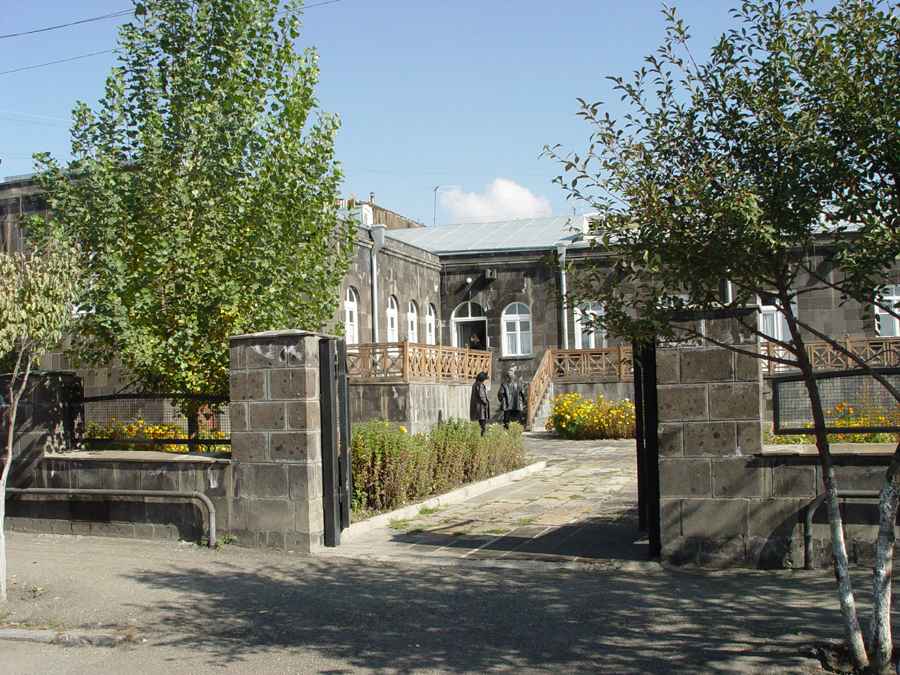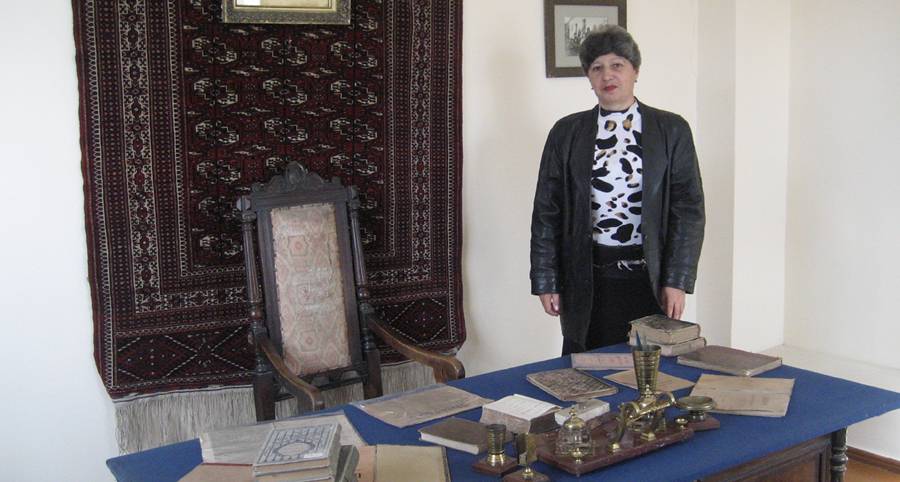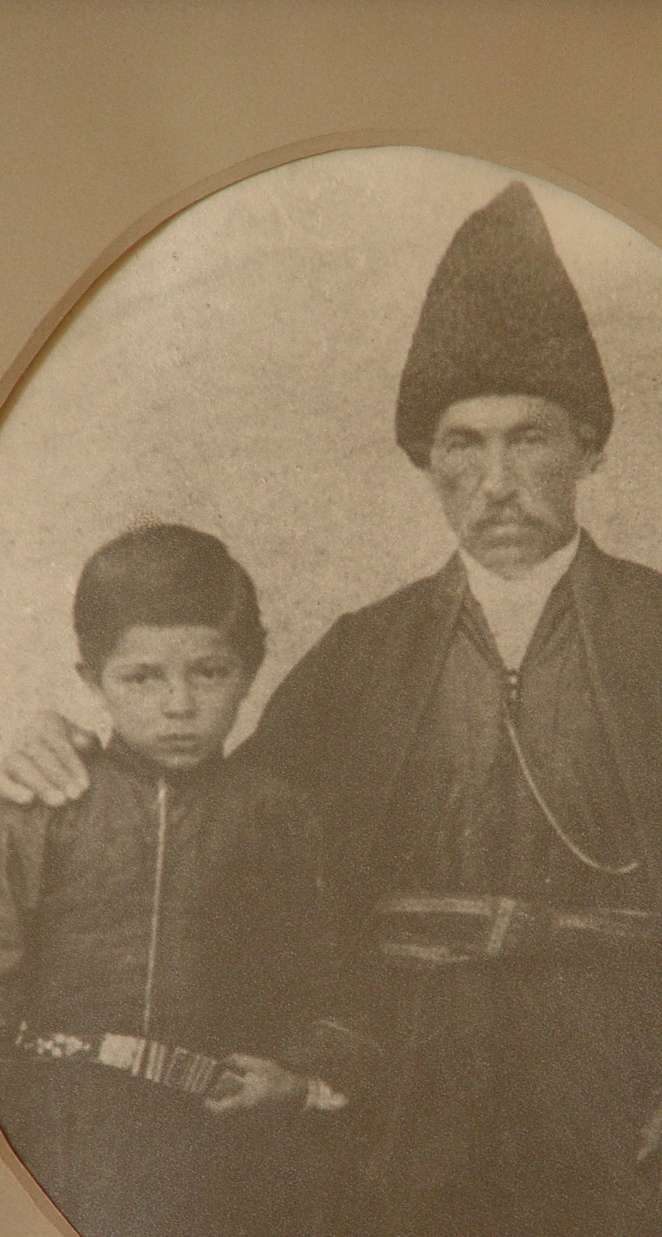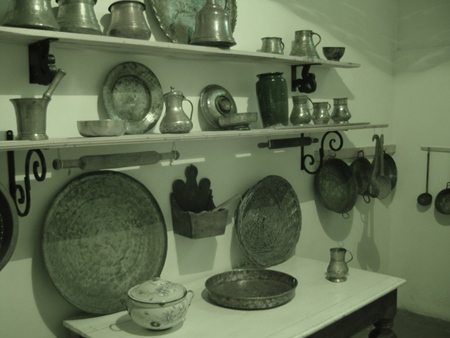
House Museum of Gyumri
(© K. Vrtanesyan)
Armenian News Network / Groong
December 19, 2006
Travel Wire
By Ruth Bedevian
YEREVAN, ARMENIA

|
|
Entrance and courtyard to Isahakyan House Museum of Gyumri (© K. Vrtanesyan) |
In 1979 a most honored guest, the Armenian-American writer William Saroyan (1908-1981), paid us a visit here in Gyumri (known then as Leninakan), proudly declared Susanna Mnasaganyan, Director of the Isahakyan House Museum of Gyumri. When he saw Isahakyan's desk, he knelt before it, kissed it and said, "Bury me here!"
Lyric poet, Avetik Sahak Isahakyan, who earned the respect of his nation and whose career was long and prolific, is honored with two house museums. The museum in Yerevan is where he lived for the last five years of his life, and the other is in Gyumri on the Street of the Masters - Varbednerou Poghotz, which is practically next door to another renowned poet's landmark - the Hovhannes Shiraz Museum. It is here in this house in Gyumri where Avetik Isahakyan was born and reared. The museum in Yerevan contains an array of memorabilia, but it is the house of his birth where he spent his childhood, that one feels the personal heritage of this great man of letters whose poetry has been generously used as lyrics for music and whose expressive words are recognized widely. It is here in this 19th century built house that one meets Isahakyan intimately.

|
|
Susanna Mnasaganyan, Director, standing at the desk of A. Isahakyan (© K. Vrtanesyan) |
One other writer possesses an equal honor and that is Hovhannes Toumanyan (1869-1923) whose boyhood home museum is located outside of Vanadzor and another in the capital city of Yerevan. Like Toumanyan, who was nurtured in the Lori region and absorbed the ancient folklore of Gougark, Isahakyan was nurtured in the Shirak region (which at the time of his youth, included the medieval capital of Ani). His imagination was kindled by the folklore of the wandering minstrels (ashughs). Isahakyan also grew up in the climate of tension at the border. Armenians in the Russian dominated Alexandropol (later to be named Leninakan under the Soviets and then returned to its original name Gyumri), formed groups to help their brothers and sisters across the border under Turkish domination. Isahakyan's brother, Aleksan, and also a relative of his sister's husband were actively involved. Their experiences and activities fired up the patriot in this would-be writer.

|
|
Maternal grandfather and Isahakyan (© K. Vrtanesyan) |
The museum suffered huge damage during the 1988 Earthquake and was too dangerous for use. Thus it was closed for 14 years, reopening in 2002. While repairs were pending and finally completed, the contents of the home were stored in Yerevan. The house is divided in two parts: Isahakyan's boyhood home where he was born and raised and his uncle's home where presently Isahakyan's works are displayed.
Susanna continued to enlighten us: On the 100th anniversary of his birth, in 1975, this house was converted into a museum. Isahakyan's grandfather had built the house in 1829. Avetik, the youngest of seven children (four boys and two girls), enjoyed a privileged childhood as the family earned a good living as millers and owned some farming property as well. Upon completing elementary school, he went to the nearby monastery of Harich from which he graduated in 1889. He then entered the prestigious Gevorkyan Seminary in Etchmiadzin.

|
|
Shoushan Isahakyan's "First Love" (© K. Vrtanesyan) |
Several photographs were interesting, but one in particular revealed the personal story of an adolescent first and unrequited love that Isahakyan held for Shoushan Metakian (1877-1944). At 16, Isahakyan was smitten with this 14 year old beauty who was a distant relative on his mothers side, the niece of his first cousin. Crushing news came to him while he was in Germany. That Shoushan had married a much older man devastated him and it was widely known that he carried her in a corner of his heart the rest of his life. In one of his journal entries he stated that he would never marry. He wrote a poem, pouring out his heart, entitled, Mountain Flowers Weep My Anguish. He was to eventually marry a woman named Sophie over a decade later (1910) and their marriage produced one child, a son who was named Viken. His wedding took place in Ani. As Susanna remarked, his heart was in Ani.

|
|
Bread storage suspended to keep away mice (© K. Vrtanesyan) |
Susanna led the way to the parents' bedroom, and then to the kitchen where original kitchenware was displayed. We viewed a storage room and a separate room adjacent to it where the family tonir (underground oven) was located and in which the family's baker prepared the bread. This gave another indication of the family's comfort. It was interesting to see how the bread was stored. It rested upon a flat surface that was suspended from the center of the ceiling. In this way hungry mice were not able to nibble away! We were able to take only a peek into the last room as it is under restoration. It is devoted to the poets works and translations into over 100 languages. The Isahakyan museum originally was a subsidiary of the Charentz Museum. Susanna told us that in 1997 jurisdiction of the museum was passed to the city of Gyumri.
By 1895 Isahakyan had returned to Gyumri and joined the Armenian Revolutionary Federation (Dashnag Party), actively participating in aiding Armenians in Western Turkey to fight against the Ottoman

|
|
Original Kitchenware of the Isahakyan household (© K. Vrtanesyan) |

|
|
Final Room - Under Restoration (© K. Vrtanesyan) |
Isahakyan is buried in Yerevan's Artists Pavilion, and excerpts from Abu-Lala Mahari are engraved upon his tombstone. But it is this House Museum of his birthplace that is a truer resting place. It is where his spirit is felt and is indeed a pride for the people of Gyumri.
-- Ruth Bedevian continues her visits in Armenia. Many of her articles are at: http://www.groong.org/orig/armeniahousemuseums.html
|
Redistribution of Groong articles, such as this one, to any other
media, including but not limited to other mailing lists and Usenet
bulletin boards, is strictly prohibited without prior written
consent from Groong's Administrator. © Copyright 2006 Armenian News Network/Groong. All Rights Reserved. |
|---|